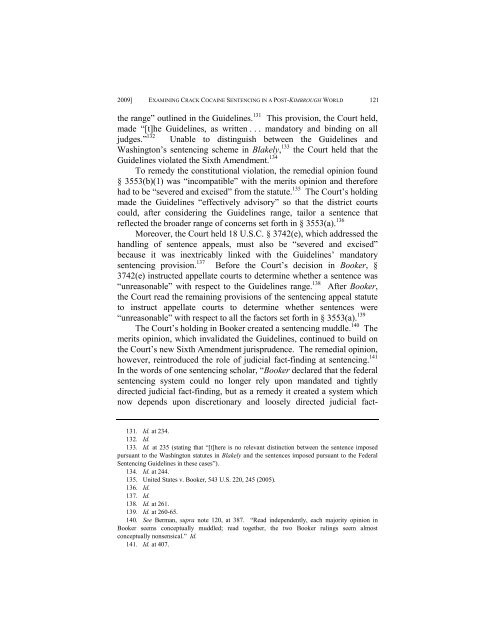Examining Crack Cocaine Sentencing in a Post- Kimbrough World
Examining Crack Cocaine Sentencing in a Post- Kimbrough World
Examining Crack Cocaine Sentencing in a Post- Kimbrough World
Create successful ePaper yourself
Turn your PDF publications into a flip-book with our unique Google optimized e-Paper software.
08-CASSIDY.DOC<br />
1/29/2009 3:29:23 PM<br />
2009] EXAMINING CRACK COCAINE SENTENCING IN A POST-KIMBROUGH WORLD 121<br />
the range” outl<strong>in</strong>ed <strong>in</strong> the Guidel<strong>in</strong>es. 131 This provision, the Court held,<br />
made “[t]he Guidel<strong>in</strong>es, as written . . . mandatory and b<strong>in</strong>d<strong>in</strong>g on all<br />
judges.” 132 Unable to dist<strong>in</strong>guish between the Guidel<strong>in</strong>es and<br />
Wash<strong>in</strong>gton’s sentenc<strong>in</strong>g scheme <strong>in</strong> Blakely, 133 the Court held that the<br />
Guidel<strong>in</strong>es violated the Sixth Amendment. 134<br />
To remedy the constitutional violation, the remedial op<strong>in</strong>ion found<br />
§ 3553(b)(1) was “<strong>in</strong>compatible” with the merits op<strong>in</strong>ion and therefore<br />
had to be “severed and excised” from the statute. 135 The Court’s hold<strong>in</strong>g<br />
made the Guidel<strong>in</strong>es “effectively advisory” so that the district courts<br />
could, after consider<strong>in</strong>g the Guidel<strong>in</strong>es range, tailor a sentence that<br />
reflected the broader range of concerns set forth <strong>in</strong> § 3553(a). 136<br />
Moreover, the Court held 18 U.S.C. § 3742(e), which addressed the<br />
handl<strong>in</strong>g of sentence appeals, must also be “severed and excised”<br />
because it was <strong>in</strong>extricably l<strong>in</strong>ked with the Guidel<strong>in</strong>es’ mandatory<br />
sentenc<strong>in</strong>g provision. 137 Before the Court’s decision <strong>in</strong> Booker, §<br />
3742(e) <strong>in</strong>structed appellate courts to determ<strong>in</strong>e whether a sentence was<br />
“unreasonable” with respect to the Guidel<strong>in</strong>es range. 138 After Booker,<br />
the Court read the rema<strong>in</strong><strong>in</strong>g provisions of the sentenc<strong>in</strong>g appeal statute<br />
to <strong>in</strong>struct appellate courts to determ<strong>in</strong>e whether sentences were<br />
“unreasonable” with respect to all the factors set forth <strong>in</strong> § 3553(a). 139<br />
The Court’s hold<strong>in</strong>g <strong>in</strong> Booker created a sentenc<strong>in</strong>g muddle. 140 The<br />
merits op<strong>in</strong>ion, which <strong>in</strong>validated the Guidel<strong>in</strong>es, cont<strong>in</strong>ued to build on<br />
the Court’s new Sixth Amendment jurisprudence. The remedial op<strong>in</strong>ion,<br />
however, re<strong>in</strong>troduced the role of judicial fact-f<strong>in</strong>d<strong>in</strong>g at sentenc<strong>in</strong>g. 141<br />
In the words of one sentenc<strong>in</strong>g scholar, “Booker declared that the federal<br />
sentenc<strong>in</strong>g system could no longer rely upon mandated and tightly<br />
directed judicial fact-f<strong>in</strong>d<strong>in</strong>g, but as a remedy it created a system which<br />
now depends upon discretionary and loosely directed judicial fact-<br />
131. Id. at 234.<br />
132. Id.<br />
133. Id. at 235 (stat<strong>in</strong>g that “[t]here is no relevant dist<strong>in</strong>ction between the sentence imposed<br />
pursuant to the Wash<strong>in</strong>gton statutes <strong>in</strong> Blakely and the sentences imposed pursuant to the Federal<br />
<strong>Sentenc<strong>in</strong>g</strong> Guidel<strong>in</strong>es <strong>in</strong> these cases”).<br />
134. Id. at 244.<br />
135. United States v. Booker, 543 U.S. 220, 245 (2005).<br />
136. Id.<br />
137. Id.<br />
138. Id. at 261.<br />
139. Id. at 260-65.<br />
140. See Berman, supra note 120, at 387. “Read <strong>in</strong>dependently, each majority op<strong>in</strong>ion <strong>in</strong><br />
Booker seems conceptually muddled; read together, the two Booker rul<strong>in</strong>gs seem almost<br />
conceptually nonsensical.” Id.<br />
141. Id. at 407.
















